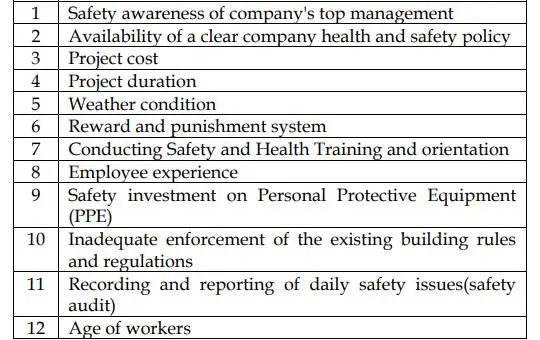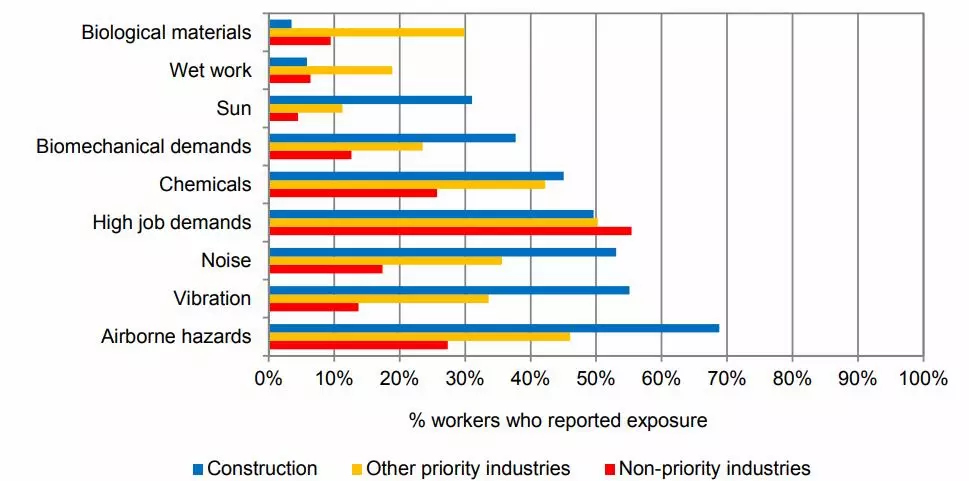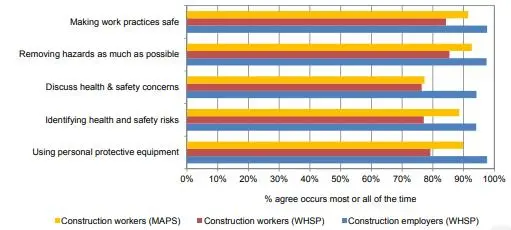Challenges and Measures to the Workplace Health and Safety Issues in Construction Projects
Question
Task:
Purpose: To conduct an analysis of workplace health and safety issues by undertaking a construction project as a case study.
Brief Description: The purpose of this individual task is to provide a better understanding of workplace health and safety issues and strategies to achieve zero accidents in construction projects. Using a case study of a selected construction project (either an actual project or a project from the literature), you are expected to analyse causes of accidents, identify health and safety issues, and develop countermeasures to enhance safety and prevent accidents in construction sites. Students are also expected to conduct a literature review on workplace health and safety in construction. Along with the case study, conducting a literature review will enhance students’ knowledge and understanding of the subject and help to develop a more comprehensive list of issues and countermeasures
Case Study Identification: Each student needs to identify a suitable and real construction project as a case study. The project can be an ongoing project or completed one. The project can be a building project, infrastructure project, or any other type of construction projects. Students should have a reasonable level of access to the case study so they will be able to collect sufficient information to complete the requirements of this assignment. Example of materials students have to have access to include, but not limited to:
- Project overview
- Project design and drawings
- Specifications and construction method
- Site layout plan
- Work health and safety plans and documents (if any)
Students who have difficulty to find a suitable construction project may use hypothetical case study or use extensive literature review instead. The literature review should cover different and high quality journal papers to answer the assignment requirements.
Requirements
- Explain health and safety issues in the construction site (from the case study or literature review).
- Identify construction injuries, hazards and risks that may occur during construction stage (from the case study or literature review).
- Propose a classification of injuries and hazards in construction sites (e.g. based on causes, based on building components, etc.).
- Develop a method to manage injuries and hazards (controlling, prevention, and minimisation).
Answer
Introduction
Construction industry plays a major and significant role in the emerging economic development of the world, as it includes a range of companies as well as active sectors along with a vast number of the worker population. However, this industry is also considered as one of the riskiest and hazardous working sectors for integrated human resources. Based on the Global report created by the International Labour Organisation, construction companies are prone to the workplace health and safety issues compared to the other corporate sectors. Universally, the poor level of performance and avoidance of safety measurements leads to around 100,000 fatal accident cases every year, which covers almost 40% of the global occupational health injuries. A report of IJSER represents that around 271 million people suffer from different kind of physical health challenges and around them, approximate 2 million people die each year. Therefore, it can be stated that improvement in the health and safety measurements, especially associated with the construction industry is required to be evaluated properly, which is the primary focus of the current report.
Overview of the project/literature
According to the statement of Fekele, Quezon & Macarubbo (2016), the workplace health and safety issues associated with the global construction sector is highly dependent on the working conditions of the workers, their intended knowledge about safety measurements, and responsibilities played by the potential stakeholders, like government, management, and workers themselves. Safety management requires the involvement of different functions, such as proper planning, identification of the problematic areas, controlling, coordinating, as well as directing the safe activities. The major aim of all the activities is to reduce or prevent the accidental rate and ill health conditions of the involved members (Bong et al. 2015). There are certain safety management objectives, which are required to be fulfilled for maintaining OHS provisions of the construction workers, such as making the working environment safe, making the tasks safely, and making workers conscious about safety.
There are several risk factors or causes integrated with the health and safety measurements of the construction industry. For example, falling is one of the most significant causes behind physical injury, and often it might lead to the death of the workers. Along with this, accidents are also involved with both offsite as well as an onsite working process. Additionally, Zaid Alkilani, Jupp & Sawhney (2013) mentioned that different other issues, like Dermatitis, Asbestosis, and Occupational Deafness might cause continuous suffering for a range of construction industry workers. As per the report generated by OSHA, there are further leading causes behind the ill health and death in the construction sites, such as electrocution, caught-in/between, or struck-by-object. In the year 2014, all of the above-mentioned factors cause total of 58% of the construction deaths in different countries. On the other hand, the ILO reports reflect the fact that in the construction industry, 60000 fatalities happen every year, which means that an accident occurs in every ten minutes within the construction sector.

Figure 1: Factors associated with health and safety issues of Construction sector workers
(Source: Fekele, Quezon & Macarubbo, 2016)
Health and Safety Issue identification
Identification of the points, from which the workplace health and safety issues might occur, is essential for avoiding unwanted circumstances. According to the viewpoint of Chan (2012), the proper focus, monitoring and control of the specified points might reduce the rate of fatal accidents like falling from heights or electric shock. However, all the involved members need to contribute equally to managing a safe working environment. For example, while a worker is working on the outside of a 10th-floor building, the supervisors and project coordinators need to focus on some associated things, such as proper tying of the safety harness rope, proper spacing between the workers and the other equipments, eliminating possibility of electric shock, and so on (Warmerdam & Lingard, 2017). However, as per the OSHA report and standard protocols, it can be stated that there are certain action items, which are necessary to involve in the identification, inspection, and assessments of the workplace health and safety hazards of construction sites.
|
Action 1: Collection of previous evidence or information about the construction site hazards |
|
|
Action 2: Inspection of the job sites for recognising the areas of safety hazards |
|
|
Action 3: Identification of health risks or hazards |
|
|
Action 4: Conduction of incident investigation |
|
|
Action 5: Identification of hazards or risks associated with the non-routine and emergency conditions |
|
|
Action 6: Characterisation of the nature of the identified risks or hazards, identification of interim controlling measurements, and prioritisation of the control hazards |
|
Table 1: Actions for identification of health and safety hazards in the Construction sector
(Source: Safety & Health Programs in Construction, 2016)
Classification of Issues
Through considering the range of reports published on the construction sector, it can be stated that the injuries or health damages can be classified in two distinctive categories, which are work-oriented issues and disease caused by exposure of different hazards. In Australia, the most common construction sector work-related injuries are cutting and wounds (31%), muscle conditions and chronic joint pain (16%), and strains and sprains (21%). According to the report statistics, 31% cases are caused by the object hitting phenomenon, 30% are caused by pulling or pushing heavy loads, and 15% is reasoned due to the falling from heights. On the other hand, 69% of the construction workers are often exposed to the airborne fumes and clouds of dust, whereas 53% and 55% of the workers experience health issues due to the extremely loud noise and high level of vibration (Work Health and Safety Perceptions- Construction Industry, 2015). Based on the perception of construction industry employers, most of the physical incidents or work-oriented injuries occur due to the carelessness of the employees.
The survey conducted by WRIS (Work-Related Injuries Survey 2009-10) represents that around the 12 million Australian workers, 8.7% of them are working in the construction industry. The survey conducted in 2010 also collected evidence that around 56,900 construction workers experience different types of workplace health and safety issue. Therefore, in Australia, the rate of work-oriented injury is 59.2 per 1000 workers in the construction industry, which is slightly higher than the OHS issues found in the other corporate sectors (Work Health and Safety Perceptions- Construction Industry, 2019). On the other hand, in most of the developing countries, like India, Bangladesh, Pakistan, Nepal, Srilanka, China, the fatal accident rate in the construction sector was in the range of 10.5% to 29.9% per 100,000 workers (Hassan, 2012). According to the 2008 report of EU, the fatal accident case and serious accident percentage were much higher compared to the other corporate industries, like manufacturing, healthcare, transportation, electricity, real estate, and so on.

Figure 2: Comparison of hazardous factors among construction workers and other industry workers
(Source: Work Health and Safety Perceptions- Construction Industry, 2015)
Additional to the physical injuries as mentioned in the above section, there certain health issues caused by the disease-causing elements. As per the report of Safe Work Australia, it can be stated that the most potential disease-causing element is airborne hazardous particles, in which 66% workers become affected due to the presence of gas and dust whereas 24% of them affected by fumes or vapours. The types of dusts include machinery particles, acrylic materials, aluminium dust, bricks, dirt, concrete, plaster, timber, and sand. Besides this, the fumes of petrol or diesel, exhaust or paint fumes might also cause breathing issues and affect the lung, heart, or some other respiratory organs of the construction workers (Work Health and Safety Perceptions- Construction Industry, 2019). These particles can mostly influence the technicians, labourers, managers, drivers, machinery operators, and trade managers. The second common risk factor for the construction workers is the presence of high vibration power, which could affect the whole body, specific parts of the body, and hearing capacity of a human being. 58% of the workers face hand-arm vibration, 19% of them experience vibration in the entire body, and 21% of the construction workers reported both types of vibration while working.
The third significant issue is louder noise, which is associated with the above health risk. Louder noise and vibration both can cause physical pains in hip and joint, legs, knees, hands, feet, wrists, backside, and neck areas. Apart from this high sun exposure might cause pigmentation, sun-burn, and sometimes the heat might lead to sudden stroke in several cases (Lingard et al. 2015). Apart from this, Various survey found that not only the physical issues, but around 32% of the workers also face mental health challenges due to the extreme work pressure, absence of work-life balance, constant working in an unhealthy environment, and so on. In the Australian construction industry, it is reported that construction workers are six-time more prone to suicide compared to the other people. 21% of the construction workers have poor mental state, in which 9% suffer from extreme depression (We Need to Talk about Mental Health in the Construction Industry, 2017).
Counter-measure
Construction employers need to undertake six top-priority compliance activities for improving the overall scenario in the construction sector, which is as follows-
- The conceptions of protective equipment and clothing
- Recognition of the workplace health and safety issues
- Consulting with all the workers working in different level
- Consulting with some other associated consultants
- Incorporating the safety measurements
- And running specific training as well as toolbox sessions (Work Health and Safety Perceptions- Construction Industry, 2019)

Figure 3: Safety measurements and practices among the construction workers
(Source: Work Health and Safety Perceptions- Construction Industry, 2015)
According to the statement of Chan et al. (2016), the construction industry employers need to include several laws, regulations, and policies in place, as in most of the absence of applying safety policies and measurements might cause greater risk. This ultimately leads to the job dissatisfaction and disengagement of the workers. It is reported by 16% of the Australian construction workers that their workplaces have anti-bullying or anti-stress policies, but in an inactive form (Sanchez, Peláez & Alis, 2017). Therefore, construction employers need to change or modify the OHS training process for all the construction workers. The report of Safe Work Australia suggests that around 61% of the workers do not get proper safety training after recruitment. Hence, as per the suggestion of OSHA, it is necessary to include all the workers, managers, and employers in the program awareness, workplace health and safety measurements and hazard identification programs (Demirkesen & Arditi, 2015). Additional to this, for efficient evaluation and improvement of the programs, it is necessary to communicate and collaborate with multiple employers, employees, and worksite supervisors, which can be considered as the ultimate OHS safety control for the construction workers.
Conclusion
The findings of the present report provide a broader perspective about the workplace health and safety issues, the risk factors, statistics, and control measures associated with the construction industry. Evidence suggests that the construction industry is always being criticised due to the record of poor health and safety provisions as well as measurements. However, the fortunate part is that now all the involved members of construction industry are constantly becoming aware of the workplace health and safety issues; therefore, the counter and control measurements for safety provisions are also improving gradually. Therefore, it is hopefully expected that through applying the advanced safety provisions and enhanced knowledge of the workers, the higher rate of the construction sector incidents would be minimised in the upcoming future.
Reference List
Bong, S., Rameezdeen, R., Zuo, J., Li, R. Y. M., & Ye, G. (2015). The designer's role in workplace health and safety in the construction industry: post-harmonized regulations in South Australia. International Journal of Construction Management, 15(4), 276-287. Retrieved 18 August 2019, from https://www.researchgate.net/profile/Rita_Yi_Man_Li/publication/283277641_The_designer%27s_role_in_workplace_health_and_safety_in_the_construction_industry_Post-harmonized_regulations_in_South_Australia/links/5b8e2650a6fdcc1ddd0a12db/The-designers-role-in-workplace-health-and-safety-in-the-construction-industry-Post-harmonized-regulations-in-South-Australia.pdf
Chan, A. P., Javed, A. A., Lyu, S., Hon, C. K., & Wong, F. K. (2016). Strategies for improving the safety and health of ethnic minority construction workers. Journal of Construction Engineering and Management, 142(9), 05016007. Retrieved 18 August 2019, from https://eprints.qut.edu.au/95587/3/95587.pdf
Chan, E. (2012). A Safety culture in construction business. Journal of Research in International Business and Management, 2(13)s, 335-340. Retrieved 18 August 2019, from https://pdfs.semanticscholar.org/10ad/717f8ac244f4efa0220cdf587bde631c4539.pdf
Demirkesen, S., & Arditi, D. (2015). Construction safety personnel's perceptions of safety training practices. International Journal of Project Management, 33(5), 1160-1169. Retrieved 18 August 2019, from
Fekele, L., Quezon, P. E. T., & Macarubbo, Y. C. (2016). Evaluation of health and safety practice in building construction: a case study in Addis Ababa. International Journal of Scientific & Engineering Research, 7(10), 122-131. Retrieved 18 August 2019, from
Hassan, S. A. (2012). Health, Safety and Environmental Practices in the Construction Sector of Pakistan. Diva-portal.org. Retrieved 18 August 2019, from http://www.diva-portal.org/smash/get/diva2:562426/FULLTEXT01.pdf
Lingard, H., Saunders, L., Pirzadeh, P., Blismas, N., Kleiner, B., & Wakefield, R. (2015). The relationship between pre-construction decision-making and the effectiveness of risk control: Testing the time-safety influence curve. Engineering, Construction and Architectural Management, 22(1), 108-124. Retrieved 18 August 2019, from https://researchbank.rmit.edu.au/view/rmit:29796/n2006051216.pdf
Safety & Health Programs in Construction. (2016). Osha.gov. Retrieved 18 August 2019, from https://www.osha.gov/shpguidelines/docs/8524_OSHA_Construction_Guidelines_R4.pdf
Sanchez, F. A. S., Peláez, G. I. C., & Alis, J. C. (2017). Occupational safety and health in construction: a review of applications and trends. Industrial health, 55(3), 210-218. Retrieved 18 August 2019, from https://www.jstage.jst.go.jp/article/indhealth/55/3/55_2016-0108/_pdf
Warmerdam, A., & Lingard, H. (2017, June). EXAMINING THE DEFINITION OF A CONSTRUCTION PROJECT IN AUSTRALIA. In Joint CIB W099 & TG59 International Safety, Health, and People in Construction Conference (p. 242). Retrieved 18 August 2019, from http://www.academia.edu/download/54664906/Contribution_of_Stress_to_Construction_S.pdf#page=262
We Need to Talk about Mental Health in the Construction Industry. (2017). CHESS Connect. Retrieved 18 August 2019, from https://www.chessconnect.org.au/mental-health-construction-industry/
Work Health and Safety Perceptions- Construction Industry. (2015). Safeworkaustralia.gov.au. Retrieved 18 August 2019, from https://www.safeworkaustralia.gov.au/system/files/documents/1702/whs-perceptions-construction-industry.pdf
Work Health and Safety Perceptions- Construction Industry. (2019). Safeworkaustralia.gov.au. Retrieved 18 August 2019, from https://www.safeworkaustralia.gov.au/system/files/documents/1702/brief-perceptions-construction-industry.pdf
Zaid Alkilani, S., Jupp, J., & Sawhney, A. (2013). Issues of construction health and safety in developing countries: a case of Jordan. Australasian Journal of Construction Economics and Building, The, 13(3), 141. Retrieved 18 August 2019, from https://epress.lib.uts.edu.au/journals/index.php/AJCEB/article/view/3301/3752












